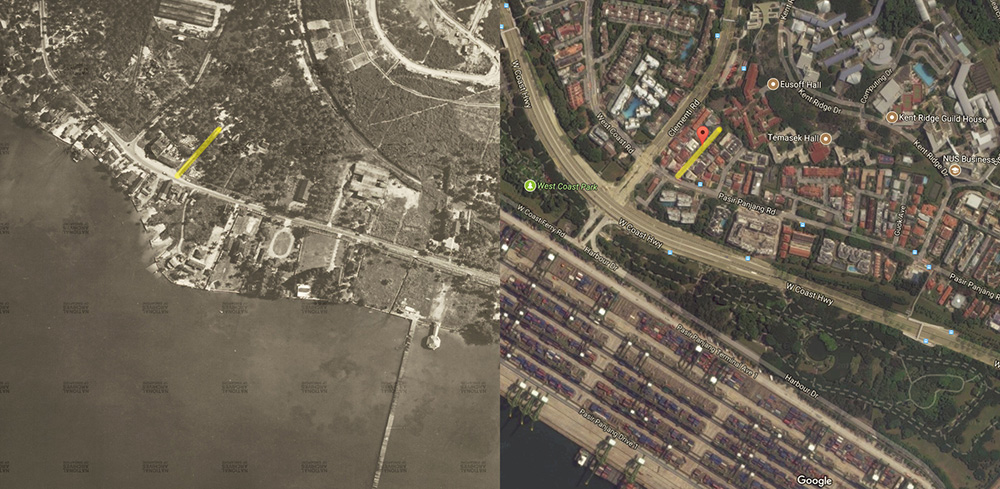
Left: Aerial photograph of Pasir Panjang in 1949. (Image credit: National Archives of Singapore)
Right: Satellite image of Pasir Panjang in 2017. (Image credit: Google Maps)
Neo Pee Teck Lane is highlighted in yellow in both images.
Singapore’s fast-changing landscape has always been rich fodder for the work of local theatremakers. There was Stella Kon’s landmark monologue Emily of Emerald Hill (1984), in which an aged Emily Gan laments the new apartment blocks surrounding her mansion on Emerald Hill. There was also Drama Box’s It Won’t Be Too Long (2015), a two-part work about spaces in Singapore, comprising The Lesson, a forum theatre piece charging audiences with selecting a fictional site to be torn down for a new MRT station, and The Cemetery, one-part movement work and one-part verbatim theatre based on the demolition of Bukit Brown Cemetery. And most recently, there was Haresh Sharma’s musical Tropicana (2017) based on the infamous cabaret and night spot in Orchard Road which closed in 1989 and was subsequently demolished. Our relationship with our ever-shifting physical environment has spawned such dramatic works and more that deal with themes like memory, loss, politics and governance.
For Neo Kim Seng, My Grandfather’s Road was a chance to consolidate memories of his childhood on Neo Pee Teck Lane. Present-day Pasir Panjang, the area where Neo Pee Teck Lane is located in, has changed much since Kim Seng was a child. The beach, in particular, used to be a stone’s throw away from his house. In fact, Pasir Panjang means ‘long beach’ in Malay.
My favourite seaside activity was walking barefoot, rubber slippers in hand, on the black-greyish muddy seabed at low tide, running after the small crabs on the soft sandy shore and overturning the rocks to see the small colourful fishes hiding underneath.
Source: My Grandfather’s Road by Neo Kim Seng (p.37).
But just a few years into Singapore’s independence, land reclamation projects had already begun on the East Coast of Singapore, changing the very shape of the island and driving the sea further away from inland. And there was talk of similar projects in the southwest of the island.
The Minister for Law and National Development, Mr. E. W. Barker, told Parliament today that in future land might have to be reclaimed from the sea along Pasir Panjang to provide a warehouse zone.
Source: Reclamation along Pasir Panjang in future. In The Straits Times (8 September 1967), http://tinyurl.com/y7ygstqs
For Pasir Panjang residents, the threat of land reclamation was looming over their seafront existence.
This fear [of reclamation] may be unfounded,” said executive Mr. Tan Heng Kee, 33. “But a lot of people wonder if we’ll lose our precious seafront.”
“It’s bad enough that the increasing sea traffic and offshore oil refineries have polluted our part of the sea with oil…
“But there are strong rumours that when the Government is finished with its East Coast project it will turn in our direction. It’ll break our hearts.”
Problem No. 1 on the western front by Lawrence Basapa. In The Straits Times (4 August 1970), http://tinyurl.com/ydbcrpxf
In 1971, their fears came to pass when the government announced that the coast along Pasir Panjang would be reclaimed to create new land for warehouses. Land reclamation works were to be undertaken by the Port of Singapore Authority. The residents were unable to stem the tide of progress.
The House gave its approval to the reclamation of 91 acres of the Pasir Panjang foreshore for ware-house development.
In seeking approval for this reclamation scheme, Minister for Law and National Development Mr. E. W. Barker said: “As a result of industrialisation and expansion of trade, the need for warehousing facilities has become acute.”
He said the reclamation would cost $20 million and would take two years to complete.
Land to be reclaimed for warehouses. In The Straits Times (31 July 1971), http://tinyurl.com/ybov8pnd
In the years to come, tons of sand and soil would be dumped along the Pasir Panjang coast, driving the sea back over four kilometres away. The new land remained barren in the years following the land reclamation as well, to allow the soil to settle and stabilise enough for construction and development.
Those of us living along Pasir Panjang Road have been hoping for quite some time that something will be done to obviate the need for us to keep our windows closed from dawn to dusk because of the lorries carrying earth for land reclamation in this area.
Dawn to dusk dust problem. In New Nation (5 October 1971), http://tinyurl.com/y8563hdj
But for a young Kim Seng, the beach of his childhood would forever disappear.
…When the sea was being reclaimed, I would walk up the dunes of sand in the seabed, but it never felt the same without the seawater and sea creatures.
I can’t remember exactly how I felt. Maybe a little sad, as I was also moving out from Grandfather’s road soon. I was too young to remember. Maybe it was better that way. It must have been quite an ugly sight as more of the sea was reclaimed. But my beautiful seabed always remained in my heart.
Source: My Grandfather’s Road by Neo Kim Seng (p.37).
By Daniel Teo
Published on 22 Nov 2017
The Vault: My Grandfather’s Road sees independent theatre-maker Neo Kim Seng revisiting his 2015 work My Grandfather’s Road. Kim Seng refreshes his original English text with translations into Singaporean and Malaysian Cantonese in an exploration of regional variations within the language. The Vault: My Grandfather’s Road is presented 23 -25 November 2017 at Centre 42 Black Box. Find out more here.






